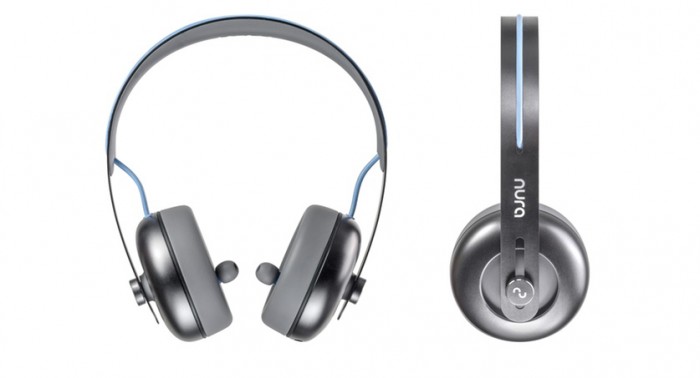These Headphones Know Your Ears Better than You Do
Kyle Slater’s headphones look a little weird. They’re big, like a pair of Beats with large cups that cover his ears, yet they also have earbuds in the middle of each cup that fit into his ear canals.
They also work differently than most headphones: they can figure out how sensitive he is to different frequencies and, working with a smartphone app, alter the music he’s listening to so that it sounds better.
Slater is CEO and cofounder of Nura, a startup that’s making these headphones, which are meant to be like a personal equalizer for your ears. To do this, the company takes advantage of what’s known as otoacoustic emissions—sounds that your inner ears produce in response to the cochlea being stimulated by a tone or other sound (this is commonly done to test hearing). Before you start listening to music with Nura’s headphones, you listen to a series of tones; a built-in microphone captures the resulting otoacoustic emissions, and that data is used to come up with a personal profile meant to sound best to you. The company claims it will work for most people, but notes its sensing is less accurate if you have major hearing loss.
Slater thinks Nura’s headphones can make it easier for audiophiles to get great-sounding music without having to try lots of different ear gear in the process. And he says Nura’s technology can also use the data it’s gathered about your hearing to identify you, so the headphones may also be useful for authentication for things like music-streaming apps.

Right now, the company has a hacked-together working prototype and a design prototype of what it hopes the product will look like in its final form. A Kickstarter campaign started this week to raise funding and interest in the device met its $100,000 goal on its first day; Nura plans to ship the headphones next year and will sell them for $399 (though, as with many Kickstarter campaigns, the company is offering them for less through that channel).
I tried out the company’s prototype headphones, which were connected both to a battery and some electronics as well as an iPhone running a Nura app (like a small number of headphones, Nura’s will connect via a phone’s lightning port or USB port, rather than the standard headphone jack, and the final product will do this in part to draw power from the phone).
Getting my sound profile took less than a minute. The resulting sound was good, though it was impossible to get a sense quickly of how much better it really was than what I’d normally hear. I listened to Bjork’s “Venus as a Boy” as processed for me by Nura’s app, processed for another Nura cofounder, Luke Campbell, and with a similarly priced pair of Bose headphones playing back an unaltered version of the song. The version that was created for me sounded a little brighter and more dynamic than the others; listening to it with Campbell’s profile turned on, for instance, included a lot more bass (the app can save three different user profiles). I could also boost the bass emitted from the outer ear cups.
The headphones were also able to recognize me easily versus Campbell; when I put them over my ears, I was greeted by an audible “Welcome back, Rachel.” (Some research indicates that otoacoustic emissions could be useful as biometric identifiers.)
Peter Torre, director of the Recreational Noise Exposure and Hearing Lab at San Diego State University, says the technology is interesting, but warns that not everyone with normal hearing has otoacoustic emissions.
Keep Reading
Most Popular
Large language models can do jaw-dropping things. But nobody knows exactly why.
And that's a problem. Figuring it out is one of the biggest scientific puzzles of our time and a crucial step towards controlling more powerful future models.
The problem with plug-in hybrids? Their drivers.
Plug-in hybrids are often sold as a transition to EVs, but new data from Europe shows we’re still underestimating the emissions they produce.
Google DeepMind’s new generative model makes Super Mario–like games from scratch
Genie learns how to control games by watching hours and hours of video. It could help train next-gen robots too.
How scientists traced a mysterious covid case back to six toilets
When wastewater surveillance turns into a hunt for a single infected individual, the ethics get tricky.
Stay connected
Get the latest updates from
MIT Technology Review
Discover special offers, top stories, upcoming events, and more.